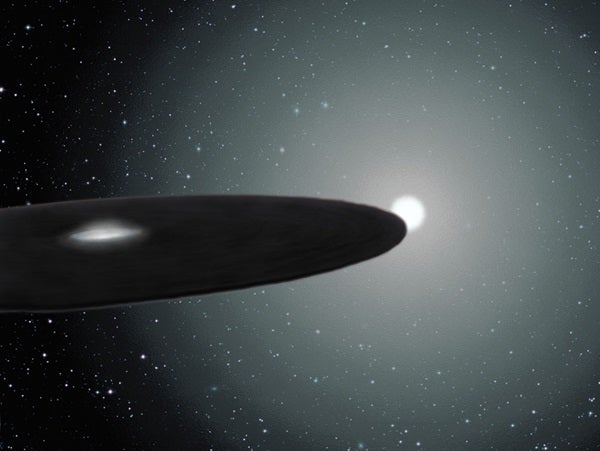As 2010 begins, the first phase of a puzzling astronomical transformation comes to an end.
In August 2009, amateur and professional astronomers reported that the bright star Epsilon Aurigae had begun to lose brightness for the first time in 27 years. It is believed that an eclipsing object of an unknown nature dims the star’s light.
The first phase of the eclipse involved a dramatic drop in brightness over the course of a few months beginning in August. Professional and amateur astronomers teamed up to monitor the eclipse and have announced that this critical phase just ended around New Year’s Day 2010.
Under normal circumstances, the star is bright enough to be seen from even the brightest of cities with just the naked eye. During eclipse, it nearly disappears from the skies of a naked-eye urban astronomer. One needs to be in a darker suburb to easily see it without helpful equipment such as binoculars.
“We have increasing evidence that a dark disk of material has moved in front of our view of Epsilon Aurigae,” said Robert Stencel, scientific advisor for the project. “But the exact shape and makeup of the disk has been unknown, but it will be better defined soon. To make things even more challenging for us, some think there are multiple stars in the system, and perhaps planets spiraling into one of the stars.”
Even during the eclipse, the star is so bright that sensitive equipment in professional observatories can have trouble monitoring its brightness in the optical wavelengths. Furthermore, large telescopes cannot afford to monitor one star continuously. This is where amateurs and citizen scientists step in.
“Amateurs are the ideal astronomers for this project,” said Arne Henden, director of the American Association of Variable Star Observers (AAVSO). “Either with their naked eyes or with digital cameras, they have proven that they can record professional-quality data. They are also distributed around the world, which helps eliminate problems such as bad weather and equipment breakdowns.”
“Just looking at the coverage in the visual data alone, I can already see interesting changes in the star that have never been seen so clearly before,” Stencel said. He studied the last event in 1982-84 while working at NASA.
If past eclipses are any guides, then this dark stage will last nearly 18 months followed by a rapid return to its normal brightness in the first half of 2011. However, the star’s brightness will continue to vary a bit during this dark stage, so amateur and professional astronomers are needed to continue vigilant monitoring.
Supported by a 3-year Informal Science Education grant from the National Science Foundation, Citizen Sky is recruiting, training, and coordinating public participation in this project. What makes this project different from previous citizen-science projects is its emphasis on participation in the full scientific method. Participants are not being asked simply to collect data. They will also be trained to analyze data, create and test their own hypotheses, and to write papers for publication in professional astronomy journals.
“Since our launch September 2009, over 2,000 participants have joined the project,” Henden said. “Over 120 observers from 19 countries have submitted over 1,500 data points. However, most participants are participating in other ways. We have teams developing data-analysis software, using robotic telescopes, and even creating illustrations and diagrams to describe different models of the system.”










